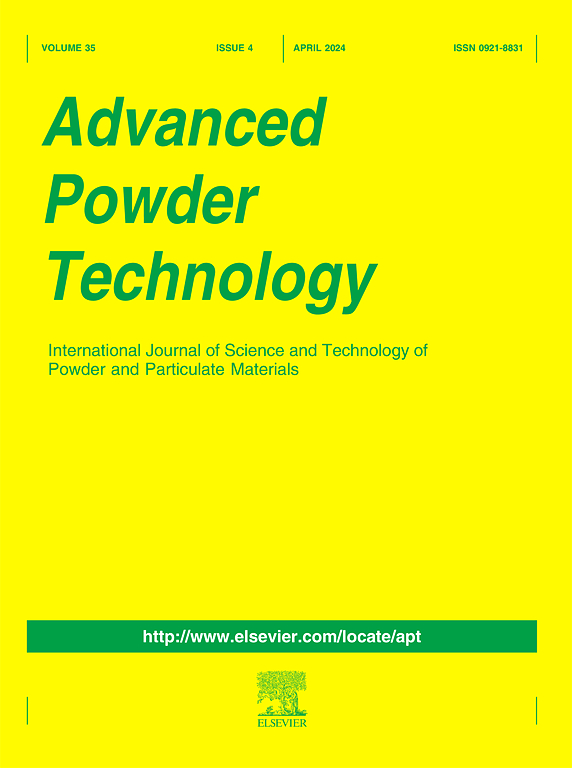Experimental study on floc-bubble interaction in the flotation of drilling wastewater at the micro-scale
IF 4.2
2区 工程技术
Q2 ENGINEERING, CHEMICAL
引用次数: 0
Abstract
Flotation is an effective solid–liquid separation technique, in which floc-bubble interactions are crucial in determining separation efficiency. This study used polyaluminum silicate ferric (PSAF) to coagulate suspended solids (SS) in drilling wastewater, agglomerating them into flocs. The interactions between bubbles and flocs of varying sizes were observed at the micro-scale using a custom-designed system. The effects of floc size on induction time, bubble relative velocity and floc-bubble interaction force were analyzed. The results indicate that small-size flocs (=50 μm) contribute to the stabilization of the liquid film while sliding along the bubble surface. In contrast, large-size flocs (=170 μm), due to their higher settling velocities, undergo multiple ‘approach-bounce’ cycles, which significantly reduce the contact time with bubbles and impair the adhesion efficiency. As floc size increases, the induction time is markedly extended. Bubbles maintain relatively stable sliding velocities on small-size flocs, while larger flocs induce pronounced velocity fluctuations, thereby heightening the separation instability. The interaction force between the floc and the bubble increases as the deformation of the floc intensifies but subsequently decreases due to the gravity of the floc.

微尺度下钻井废水浮选中絮凝-气泡相互作用的实验研究
浮选是一种有效的固液分离技术,其中絮凝—气泡的相互作用是决定分离效率的关键。本研究采用聚硅酸铝铁(PSAF)对钻井废水中的悬浮固体(SS)进行混凝,使其凝聚成絮凝体。在微尺度上,利用定制的系统观察了不同粒径的气泡与絮凝体之间的相互作用。分析了絮团粒径对诱导时间、气泡相对速度和絮泡相互作用力的影响。结果表明:小粒径(=50 μm)的絮凝体有利于液膜在气泡表面滑动时的稳定;相比之下,大粒径(=170 μm)絮凝体由于沉降速度更快,会经历多次“接近-反弹”循环,这显著减少了与气泡的接触时间,降低了附着效率。随着絮团粒径的增大,诱导时间明显延长。气泡在小粒径絮凝体上保持相对稳定的滑动速度,而在大粒径絮凝体上产生明显的速度波动,从而加剧了分离的不稳定性。随着絮体变形的加剧,絮体与气泡之间的相互作用力增大,但随后由于絮体的重力作用而减小。
本文章由计算机程序翻译,如有差异,请以英文原文为准。
求助全文
约1分钟内获得全文
求助全文
来源期刊

Advanced Powder Technology
工程技术-工程:化工
CiteScore
9.50
自引率
7.70%
发文量
424
审稿时长
55 days
期刊介绍:
The aim of Advanced Powder Technology is to meet the demand for an international journal that integrates all aspects of science and technology research on powder and particulate materials. The journal fulfills this purpose by publishing original research papers, rapid communications, reviews, and translated articles by prominent researchers worldwide.
The editorial work of Advanced Powder Technology, which was founded as the International Journal of the Society of Powder Technology, Japan, is now shared by distinguished board members, who operate in a unique framework designed to respond to the increasing global demand for articles on not only powder and particles, but also on various materials produced from them.
Advanced Powder Technology covers various areas, but a discussion of powder and particles is required in articles. Topics include: Production of powder and particulate materials in gases and liquids(nanoparticles, fine ceramics, pharmaceuticals, novel functional materials, etc.); Aerosol and colloidal processing; Powder and particle characterization; Dynamics and phenomena; Calculation and simulation (CFD, DEM, Monte Carlo method, population balance, etc.); Measurement and control of powder processes; Particle modification; Comminution; Powder handling and operations (storage, transport, granulation, separation, fluidization, etc.)
 求助内容:
求助内容: 应助结果提醒方式:
应助结果提醒方式:


